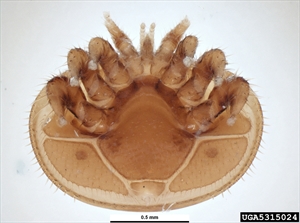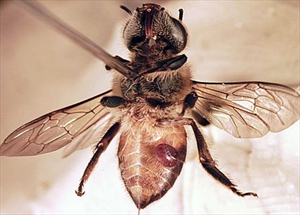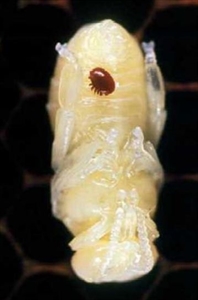- Widespread distribution. Normally, only on Asian honeybees where it is not a serious pest. Recently, found on European bees (Papua New Guinea).
- Adult female reddish-brown to dark brown, flattened, oval (crab-like), up to 1.8 mm long, 2 mm wide, on the thorax or in abdominal folds; males yellowish, with lightly tanned legs and spherical bodies, about 1 mm diameter.
- Mites enter brood cells, lay eggs, nymphs feed on bee larvae and pupae, mate, males die, and females attach and feed on bees. Note, only reproduce on male bee larvae as bees remove them from worker bee larvae and brood cells.
- Spread: (i) within hive - they are mobile; (ii) infested bees enter nearby hives to rob nectar, or by mistake; (iii) swarming; iv) infested combs put in healthy hives.
- Cultural control: use open-screen floor hives; avoid using combs from brood area in honey area; hygiene: (i) queen bees and equipment from trusted sources; (ii) clean and sterilise borrowed, second-hand equipment, tools, gloves, pallets, boxes; (iii) inspect brood combs regularly; (iv) replace brood combs every 3 years.
- Chemical control: see full fact sheet for details of treating hives, equipment, and mite infestations on bees.
Pacific Pests, Pathogens and Weeds - Online edition
Pacific Pests, Pathogens, Weeds & Pesticides
Varroa (jacobsoni) mite (326)
Varroa mite, bee mite
Varroa jacobsoni. Note, in 2000, research found that the population of Varroa jacobsoni was made up of two species, Varroa jacobsoni and Verroa destructor. The latter is the damaging species of European honeybees (see Fact Sheet no. 327).
AUTHOR Grahame Jackson
Information from BeeAware. Plant Health Australia. (http://beeaware.org.au/archive-pest/varroa-mites/#ad-image-0); and Biosecurity manual for beekeepers. (https://beeaware.org.au/wp-content/uploads/2019/05/Biosecurity-Manual-for-Beekeepers.pdf); Varroa mite (2020) Varroa mite detection in Townsville. Department of Agriculture and Fisheries. Queensland Government. (https://www.business.qld.gov.au/industries/farms-fishing-forestry/agriculture/land-management/health-pests-weeds-diseases/pests/invasive-animals/prohibited/varroa-mite). Photo 1 Lilia De Guzman, Bugwood.org. Photos 2-4 Walker K (2005) Varroa Mite (Varroa jacobsoni). PaDIL - (http://www.padil.gov.au).
Produced with support from the Australian Centre for International Agricultural Research under project PC/2010/090: Strengthening integrated crop management research in the Pacific Islands in support of sustainable intensification of high-value crop production, implemented by the University of Queensland and the Secretariat of the Pacific Community.







